|
|
 |
 Home >
IEA Home >
IEA |
| |
|
|
|
|
|
| |
 |
 |
As economic growth in the Asia- Pacific region
continues, it is becoming a greater challenge to policy-makers
to balance environmental protection with socio-economic development.
Innovative policies are needed to help make development environmentally
benign and to reduce undesirable trade-offs between development
and environmental protection. |
|
 |
 |
 |
IEA Products |
 |
The Integrated Environmental Assessment (IEA)
sub-project will provide a set of computer simulation models
as well as a strategic database, that can be used to systematically
assess development strategies in the Asia-Pacific region.
The models include an energy-technology model (AIM/Energy),
a material-economy model (AIM/Material), a multi-regional simple
trend model (AIM/Trend), ecosystem models containing water,
agriculture,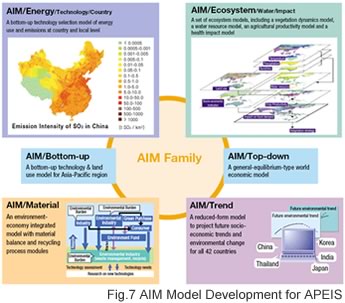 vegetation and health elements (AIM/Ecosystem and AIM/Water),
and overall integrated models (AIM/CGE and AIM/bottom-up) (Fig.7)
vegetation and health elements (AIM/Ecosystem and AIM/Water),
and overall integrated models (AIM/CGE and AIM/bottom-up) (Fig.7)
These models use data provided by IEM and can also be used to
evaluate the policy effects of innovation options prepared by
RISPO (to be explained below). |
|
|
|
 |
 |
 |
 |
 |
IEA Achievements in 2002 |
 |
IEA completed the full versions of two of its
assessment models - AIM/Trend and AIM/Energy - and developed
preliminary versions of four other models - AIM/CGE,AIM/Material,
AIM/Ecosystem, and AIM/Water.It also prepared a preliminary
version of its strategic database, preliminary projections of
some environmental trends, and preliminary assessments of possible
innovations. IEA held its first capacity building workshop in
India in October 2002. |
|
 |
AIM/Material is a country-based model to
assess the effects of environmental investment and the
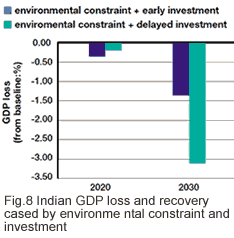 evolution
of environmental industry based on economic flows and
material balances, was modified for use in India and incorporated
a module on the naturalenvironment. AIM/Material, as applied
to India, demonstrated that investment in the environmental
industry in India could substantially compensate for economic
restrictions caused by policies to reduce industrial wastes.
It also demonstrated that early investment in land conservation
measures could provide substantial national financial
benefits (Fig.8). evolution
of environmental industry based on economic flows and
material balances, was modified for use in India and incorporated
a module on the naturalenvironment. AIM/Material, as applied
to India, demonstrated that investment in the environmental
industry in India could substantially compensate for economic
restrictions caused by policies to reduce industrial wastes.
It also demonstrated that early investment in land conservation
measures could provide substantial national financial
benefits (Fig.8). |
|
|
 |
A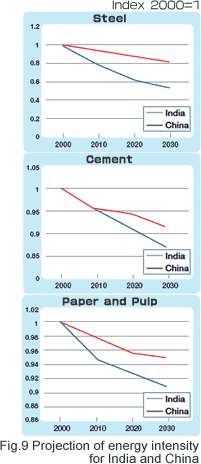 IM/Energy
is a technology selection model for energy use, and it
was applied to India and China. IM/Energy
is a technology selection model for energy use, and it
was applied to India and China.
It clarifies the reasons behind China's substantial improvements
in energy efficiency and CO2 reduction during the 1990s.
Technological progress in its steel, power generation
and building materials industries, use of cleaner fuels,
structural changes in its economy, and stringent environmental
policies all contributed to China's improved environmental
situation. The marginal cost of further improvements in
China is high; however, this is not the case for India.
India could greatly increase its energy efficiencies at
a relatively low cost (Fig.9). |
|
|
|
|
 |
AIM/Trend is a multi-regional model with
a simple structure that can project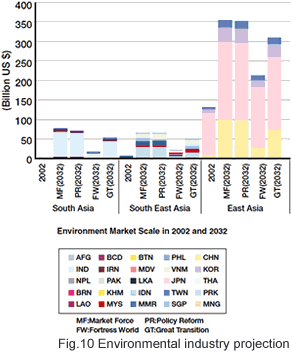
the changes in the economy, energy use and state of the
environment over
the next 30 years. It was used to simulate market development
of the environmental industry sector for each subregion
in Asia using four different scenarios - Market Forces,
Policy Reform, Fortress World and Great Transition (Fig.10).
The growth potential for the environmental industry in
East Asia can readily be seen in the figure. |
|
|
|
|
 |
AIM/CGE (Asia) is a multi-regional, multi-sectoral,computable
general equilibrium model being developed to assess the
environmental and economic effects of new markets, new
investment, technology transfer and international trade.
It uses output from AIM/Trend as benchmarks for assessing
future scenarios for different Asian countries. |
 |
AIM/Ecosystem links a set of ecosystem models
to an economic model in order to provide integrated assessments
of total ecosystem change (Fig.11). |
|
 |
|
|
|
 |
|
It is specifically being developed for application
to policy scenarios of the Millennium Ecosystem Assessment
(MA) process. Preliminary results indicate that globalization-based
development will accelerate ecosystem degradation, while
regional-based development, provides the best option for
ecosystem conservation (Fig.12). |
|
 |
|
|
|
 |
|
AIM/Ecosystem has been used to model stress
on regional water resources (Fig.13). |
|
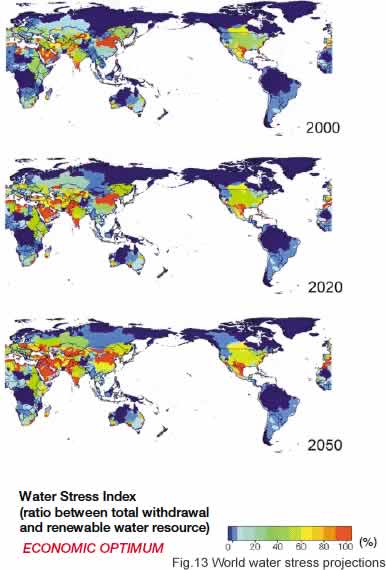 |
|
|
|
|
|
|
|
|
|
|
|
|
 |
 |
 |
 |
 |
IEA Major Progress in 2003 |
 |
 |
Completion of Advanced version of AIM/Energy, AIM/Material, AIM/Top-down,
and AIM/Ecosystem, and 1st version of Strategic Database (SDB) with indicators
focusing on environmental efficiency. |
 |
At IEA workshop in Thailand, teams in each country using IEA models, and
hove collected existing data, project future year's data, design socio-economic
scenarios, and identified abatement options for selected countries with
consultation of various policy-makers.
More Details in IEA Technical Summaries 2004 (PDF) |
|
|
 |
 |
 |
 |
 |
 |
IEA Major Progress in 2004 |
 |
 |
User-friendly APEIS/SDB with extensive database
of technological, institutional and management innovation
options |
 |
Enhancement of AIM/Material to assess environmental
investments |
 |
Development of quantitative innovation scenarios
and assessment for transport, residential, rural electrification
and water management sectors in China, India, Korea and
Thailand |
 |
A training workshop was held to enhance
model building capacity.
More Details in
IEA Technical Summaries 2005 (PDF) |
|
|
 |
 |
 |
 |
|